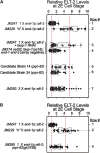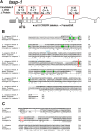A Strategy To Isolate Modifiers of Caenorhabditis elegans Lethal Mutations: Investigating the Endoderm Specifying Ability of the Intestinal Differentiation GATA Factor ELT-2
- PMID: 29593072
- PMCID: PMC5940137
- DOI: 10.1534/g3.118.200079
A Strategy To Isolate Modifiers of Caenorhabditis elegans Lethal Mutations: Investigating the Endoderm Specifying Ability of the Intestinal Differentiation GATA Factor ELT-2
Abstract
The ELT-2 GATA factor normally functions in differentiation of the C. elegans endoderm, downstream of endoderm specification. We have previously shown that, if ELT-2 is expressed sufficiently early, it is also able to specify the endoderm and to replace all other members of the core GATA-factor transcriptional cascade (END-1, END-3, ELT-7). However, such rescue requires multiple copies (and presumably overexpression) of the end-1p::elt-2 cDNA transgene; a single copy of the transgene does not rescue. We have made this observation the basis of a genetic screen to search for genetic modifiers that allow a single copy of the end-1p::elt-2 cDNA transgene to rescue the lethality of the end-1 end-3 double mutant. We performed this screen on a strain that has a single copy insertion of the transgene in an end-1 end-3 background. These animals are kept alive by virtue of an extrachromosomal array containing multiple copies of the rescuing transgene; the extrachromosomal array also contains a toxin under heat shock control to counterselect for mutagenized survivors that have been able to lose the rescuing array. A screen of ∼14,000 mutagenized haploid genomes produced 17 independent surviving strains. Whole genome sequencing was performed to identify genes that incurred independent mutations in more than one surviving strain. The C. elegans gene tasp-1 was mutated in four independent strains. tasp-1 encodes the C. elegans homolog of Taspase, a threonine-aspartic acid protease that has been found, in both mammals and insects, to cleave several proteins involved in transcription, in particular MLL1/trithorax and TFIIA. A second gene, pqn-82, was mutated in two independent strains and encodes a glutamine-asparagine rich protein. tasp-1 and pqn-82 were verified as loss-of-function modifiers of the end-1p::elt-2 transgene by RNAi and by CRISPR/Cas9-induced mutations. In both cases, gene loss leads to modest increases in the level of ELT-2 protein in the early endoderm although ELT-2 levels do not strictly correlate with rescue. We suggest that tasp-1 and pqn-82 represent a class of genes acting in the early embryo to modulate levels of critical transcription factors or to modulate the responsiveness of critical target genes. The screen's design, rescuing lethality with an extrachromosomal transgene followed by counterselection, has a background survival rate of <10-4 without mutagenesis and should be readily adapted to the general problem of identifying suppressors of C. elegans lethal mutations.
Keywords: C. elegans; ELT-2 GATA factor; Mutant Screen Report; endoderm specification; intestine; pqn-82; tasp-1; taspase.
Copyright © 2018 Wiesenfahrt et al.
Figures






Similar articles
-
The function and regulation of the GATA factor ELT-2 in the C. elegans endoderm.Development. 2016 Feb 1;143(3):483-91. doi: 10.1242/dev.130914. Epub 2015 Dec 23. Development. 2016. PMID: 26700680 Free PMC article.
-
Quantitating transcription factor redundancy: The relative roles of the ELT-2 and ELT-7 GATA factors in the C. elegans endoderm.Dev Biol. 2018 Mar 15;435(2):150-161. doi: 10.1016/j.ydbio.2017.12.023. Epub 2018 Jan 31. Dev Biol. 2018. PMID: 29360433 Free PMC article.
-
The GATA factor ELT-3 specifies endoderm in Caenorhabditis angaria in an ancestral gene network.Development. 2022 Nov 1;149(21):dev200984. doi: 10.1242/dev.200984. Epub 2022 Oct 24. Development. 2022. PMID: 36196618 Free PMC article.
-
The Caenorhabditis elegans intestine.Wiley Interdiscip Rev Dev Biol. 2013 May-Jun;2(3):347-67. doi: 10.1002/wdev.93. Epub 2012 Oct 9. Wiley Interdiscip Rev Dev Biol. 2013. PMID: 23799580 Review.
-
GATA factors as key regulatory molecules in the development of Drosophila endoderm.Dev Growth Differ. 2005 Dec;47(9):581-9. doi: 10.1111/j.1440-169X.2005.00836.x. Dev Growth Differ. 2005. PMID: 16316403 Review.
Cited by
-
Evolution and Developmental System Drift in the Endoderm Gene Regulatory Network of Caenorhabditis and Other Nematodes.Front Cell Dev Biol. 2020 Mar 18;8:170. doi: 10.3389/fcell.2020.00170. eCollection 2020. Front Cell Dev Biol. 2020. PMID: 32258041 Free PMC article. Review.
-
Evolutionary Change in Gut Specification in Caenorhabditis Centers on the GATA Factor ELT-3 in an Example of Developmental System Drift.J Dev Biol. 2023 Jul 8;11(3):32. doi: 10.3390/jdb11030032. J Dev Biol. 2023. PMID: 37489333 Free PMC article. Review.
-
Model Organism Modifier (MOM): a user-friendly Galaxy workflow to detect modifiers from genome sequencing data using Caenorhabditis elegans.G3 (Bethesda). 2023 Nov 1;13(11):jkad184. doi: 10.1093/g3journal/jkad184. G3 (Bethesda). 2023. PMID: 37585487 Free PMC article.
References
Publication types
MeSH terms
Substances
Grants and funding
LinkOut - more resources
Full Text Sources
Other Literature Sources
Research Materials
Miscellaneous
